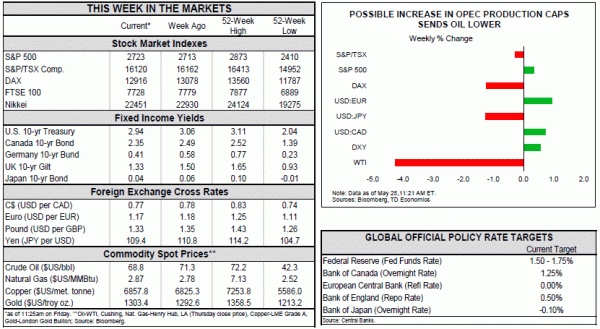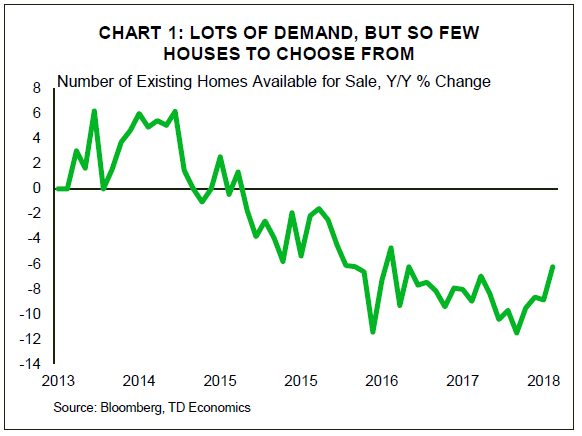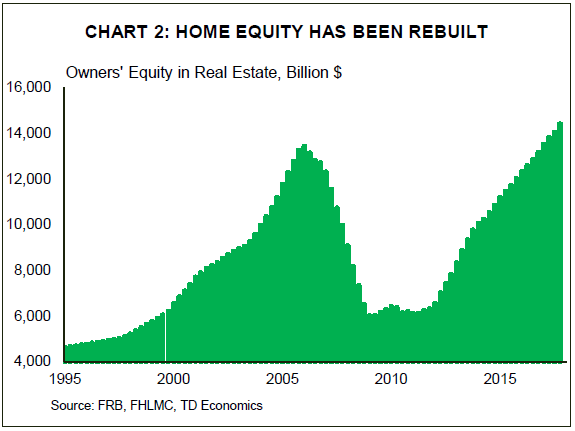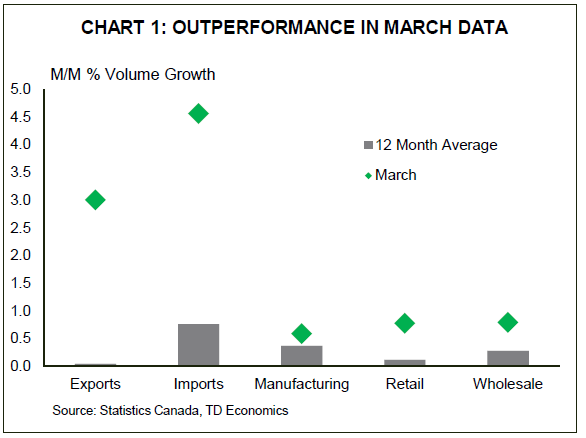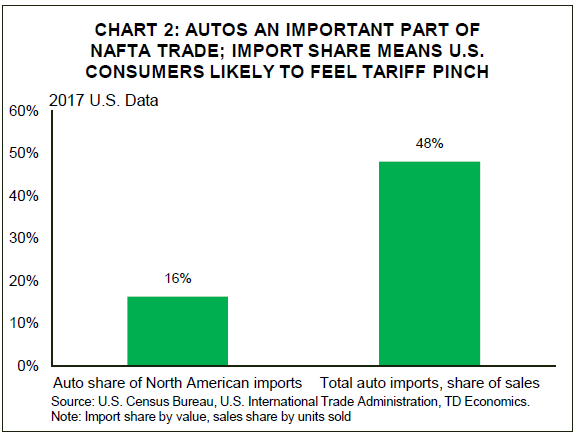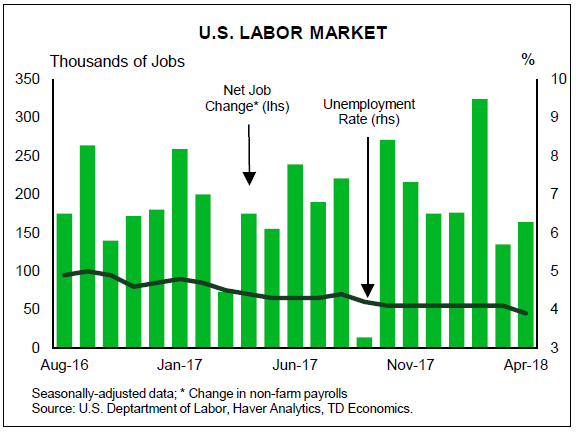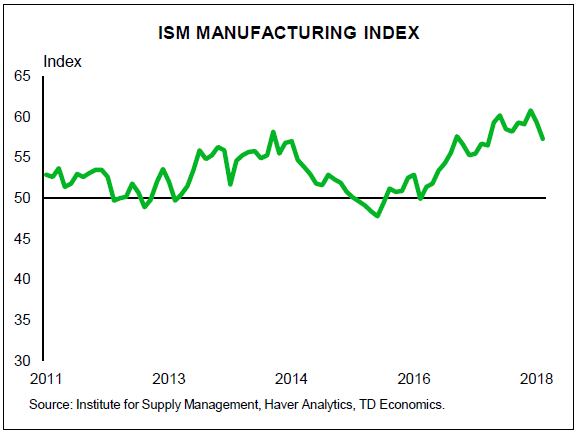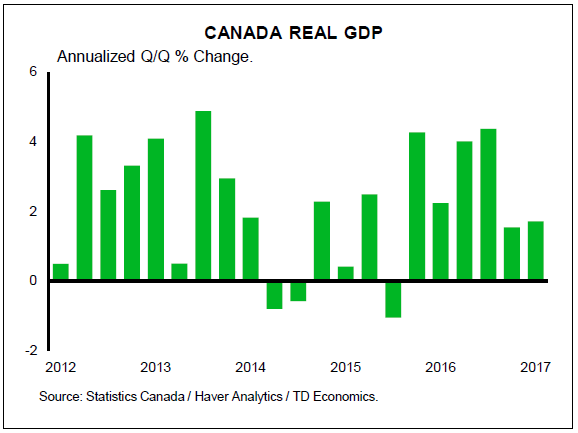U.S. Highlights
- U.S. trade tensions with China have temporarily subsided, however they have flared up elsewhere, as President Trump ordered a review of U.S. automotive imports.
- Trade tensions were also flagged as a key risk in the latest FOMC minutes. However, the Committee remained in agreement that it would soon need to “take another step” in removing monetary accommodation.
- Falling affordability and lack of inventory, continued to weigh on the U.S. housing market activity. After a weak first quarter, existing home sales have started the second quarter on a weak footing, falling 2.5% in April. Sales of new homes also declined during the same month.
Canadian Highlights
- Oil was driving Canadian markets, as indications from OPEC and Russia that more supply may be coming sent the benchmark WTI contract below U.S. $69/barrel. This weakened the S&P/TSX index, and shaved a cent from the loonie.
- On the economic data front, it was a quiet week as wholesale trade reaffirmed the theme of solid economic data for March. Canada seems to have shaken off the soft start to the year. Real GDP for the first quarter is expected to be reported at 1.8% q/q annualized, with solid momentum heading into the second quarter.
- External developments were less constructive. U.S. threats of auto tariffs have thrown yet another wrench into NAFTA renegotiations, further dimming the prospects for a near-term conclusion.
U.S. – Markets Respond to Geopolitics and the Fed
The FOMC minutes, renewed trade tensions and a cancellation of the June summit with North Korea made the week anything but boring for investors. It was also a politically-charged week across the Atlantic. U.K. negotiations with the EU soured over U.K.’s participation in the Galileo satellite project, while the new Italian Eurosceptic government appointed Giuseppe Conte as prime minister.
Financial markets rallied on Monday on the news of positive weekend developments in the U.S.-China trade dispute. Details of the agreement were vague and largely unquantifiable as far as trade deficit reduction targets are concerned. In the follow-up statement China agreed to “meaningfully” increase imports of U.S. agricultural and energy products, and lowered tariffs on imports of autos and parts. These relatively limited concessions were sufficient to put the proposed tariffs on $50 billion worth of Chinese goods set to take effect on May 21 on hold.
Although U.S. trade tensions with China have eased for now, they have flared up elsewhere, weighing on market sentiment later in the week. On Wednesday President Trump ordered a review of automotive imports, citing national security concerns. The decision drew sharp international criticism and warnings of retaliatory tariffs, but was also opposed domestically. Automakers as well as Republican lawmakers expressed concerns that, if imposed, auto tariffs will raise auto prices for consumers, disrupt supply chains, start trade wars and alienate U.S. allies.
Worries about trade also showed up in the FOMC minutes. Specifically, the FOMC members acknowledged that trade uncertainty could hurt business sentiment and investment intentions. As for the monetary policy discussion, the FOMC members agreed that they would soon need to “take another step” in removing monetary accommodation, with a June rate hike looking like a done deal. At the same time they stressed that the Fed’s inflation objective is “symmetric”, suggesting they will allow inflation to temporarily overshoot 2%. All told, we remain of the view that a total of three rate hikes this year is the most likely outcome.
Higher interest rates will certainly have an impact on the housing market. After declining by 6% in the first quarter, existing home sales have started the second quarter on a weak footing as activity fell 2.5% in April. Sales of new homes also took a break in April, declining by 1.5%. Since the start of the year, the average rate on a 30-year mortgage rose by 70 basis points. Rising rates alongside brisk growth in home prices have dented affordability; however, this is only part of the story behind relatively tepid home sales. Low inventory of houses on the market has been the most important factor restraining resale activity (Chart 1), but the pace of construction remains modest and will likely be contained by labor shortages and rising input costs. The price of American steel rose 40% this year, while lumber prices are up 34%. Some relief to the housing shortage may come as more existing homeowners, with fully rebuilt home equity (Chart 2), become encouraged to list their homes. However, the overall pace of activity in the housing market will likely once again remain modest this year.
Canada – Solid Data, Shaky Backdrop
The shortened trading week saw oil prices once again in the driver’s seat for Canadian markets. OPEC and Russia indicated a willingness to expand supply by around 1 million barrels per day to offset production losses elsewhere. Traders reacted by sending the benchmark West Texas Intermediate (WTI) contract lower. After starting the week north of U.S. $72 per barrel, it now looks set to end it south of $69. This adjustment pushed the TSX composite index slightly lower. The bigger impact was on the loonie, which was down more than a cent at the time of writing, appearing set to end the week around 77 cents U.S.
In contrast to market developments, the past week was a bit quiet on the data front, but continued the recent theme of outperformance. A 0.8% gain in wholesale trade volumes rounded out the ‘real’ data for March, joining other indicators in breaking out from recent trends (Chart 1). As expected, it’s now clear that the slow start to the year was a reflection of one-off factors rather than any dramatic shift in underlying economic conditions.
That said, the improvement in Canada’s recent economic performance has come a bit too late to meaningfully impact first quarter growth. Next Thursday’s GDP data is expected to reveal a 1.8% annualized pace of growth, driven by consumer spending and non-residential investment. This is a bit above initial expectations and in-line with Canada’s trend pace. Importantly, the same report should reveal solid momentum heading into the second quarter. Regardless, it will be a day late for the Bank of Canada to incorporate in next Wednesday’s interest rate decision. First quarter growth may be set to come in above their April forecast, but with housing markets still in an adjustment phase and considerable external uncertainties, no change in monetary policy is expected.
To this point, it is hard to see many signs of improvement in the external backdrop. President Trump this week announced a review of auto imports along national security lines – similar to the process that led to aluminum and steel tariffs (of note, Canada’s exemption is set to expire next Friday, June 1). While an exemption for Canada is possible, it represents another, much larger threat to Canadian exporters. With highly integrated supply chains across North America, auto tariffs of up to 25% (as reported) would have a disastrous impact on all NAFTA members (Chart 2). Not only are motor vehicles an important part of North American trade, imported vehicles, regardless of origin, remain in demand, as shown by U.S. sales figures. About half of the new vehicles sold in the U.S. in 2017 were imported (roughly 1 in 4 from Mexico or Canada). Any tariff, let alone one of 25%, will be felt by U.S. consumers.
President Trump’s latest threat may ultimately prove to be another negotiating tactic in the ongoing NAFTA saga, particularly since such a visible price increase is unlikely to be popular among voters. But, it adds yet another challenge to already difficult negotiations. Not only does the auto file remain murky, there have been few signs of progress in other contentious areas, such as dispute resolution. Given the realities of the North American political calendar (Mexican presidential elections in July, U.S. midterms in November) it appears that this cloud of uncertainty will be sticking around for some time to come.
U.S.: Upcoming Key Economic Releases
U.S. Employment – May
Release Date: June 1, 2018
Previous Result: 164k; unemployment rate: 3.9%
TD Forecast: 200k, unemployment rate: 3.9%
Consensus: 190k, unemployment rate: 3.9%
We expect nonfarm payrolls to pick up by 200k in May. The weaker than expected sub-200 prints over March and April partly reflected weather related impacts, suggesting some giveback. However, limiting the rebound is the late stage of this expansion which has contributed to the steady fall in the average pace of payrolls gains (190k vs its peak of 260k in early 2015). Employment surveys (ISM non-manufacturing in particular) also point to more moderate job gains in the months ahead. We therefore see limited scope for substantial upside above 200k.
We expect the unemployment rate to stabilize at 3.9% assuming a stable participation rate, which inched lower in the prior month. We expect average hourly earnings to rise 0.2% m/m. With the 12th of the month landing on Saturday, reference week effects point to a weak print. However, mean reversion from the weak m/m April gain does bias the increase upward. A 0.2% m/m gain should keep the y/y pace unchanged at 2.6% y/y.
U.S. ISM Manufacturing Sales – May
Release Date: June 1, 2018
Previous Result: 57.3
TD Forecast: 58.2
Consensus: 58.0
We expect ISM to rebound to 58.2 in May, partially reversing its slide and leaving the index at a solid level consistent with above-trend growth. Regional surveys continued to paint a robust picture (Empire and Philly). Confirmation of a pickup would assuage concerns that sentiment is weakening, as indicated by our US survey surprise index, though risks like trade policy still remain.
Canada: Upcoming Key Economic Releases
Canadian Real GDP – Q1 & March
Release Date: May 31, 2018
Previous Result: 1.7% q/q (saar), 0.4% m/m
TD Forecast: 1.8% q/q (saar), 0.2% m/m
Consensus: 2.0% q/q (saar), 0.2% m/m
Soft data early in the quarter should hold Canadian growth to an on-trend pace of 1.8% (q/q, annualized). Beneath the modest headline are divergent domestic and external paths. Final domestic demand is expected to record a solid 3.5% expansion, while net exports are expected to drag on growth as outgoing shipments of goods were effectively flat. Healthy aggregate income growth and solid retail sales figures (notably auto sales) point to a roughly 3% pace of consumer spending. Residential investment is expected to record a 10.5% decline as a significant pullback in resale activity swamps still healthy construction activity. Conversely, a healthy, 4.5% pace of expansion in non-residential investment is likely, with broad-based gains anticipated as firms continue to recover from the pull-back of 2015/2016.
Industry-level GDP should post a 0.2% advance in March on strength from services with goods output impacted by maintenance shutdowns in the oil sands. Residential construction investment also decelerated in March, showing early signs of stress in response to the slowdown in the resale market. Manufacturing output should anchor the goods sector after a solid advance in factory sales and exports, while utilities should also contribute positively. On the other side of the ledger, services should benefit from strong retail and wholesale activity while ongoing housing market softness will continue to exert a drag on real estate. A 0.2% print would provide a decent hand-off to Q2, where GDP growth is tracking in line with the Bank of Canada’s 2.5% estimate.




